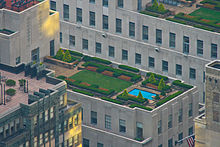Roof garden
**Historical Significance and Evolution**:
– Humans have cultivated plants on structures since ancient Mesopotamia.
– The Roman Villa of the Mysteries featured an elevated terrace with plants.
– Roof gardens existed in the medieval Egyptian city of Fustat.
– The Hanging Gardens of Babylon depict tall structures with vegetation.
– Rooftop gardens in New York City date back to the late 1800s.
– Byzantine gardens influenced early rooftop garden designs.
– Islamic architecture in Cairo featured rooftop gardens for cooling.
– Rooftop gardens have been part of urban landscapes for centuries.
– Early rooftop gardens were used for food production and relaxation.
**Environmental Impact**:
– Rooftop gardens reduce heat absorption of buildings.
– Plant surfaces stay cooler due to transpiration.
– Rooftop gardens can cool the environment by 6.5–20.3°F.
– They reduce the urban heat island effect and lower energy consumption.
– Rooftop gardens help reduce rain runoff and stormwater issues.
– Cooling effect reduces energy consumption for air conditioning.
– Rooftop gardens absorb rainwater, reducing stormwater runoff.
– Green roofs contribute to urban agriculture and food security.
– Enhance biodiversity by providing habitats for birds and insects.
**Urban Agriculture and Design**:
– Rooftop gardens support small-scale urban agriculture.
– They provide fresh produce for local communities.
– Hydroponics and alternative methods expand rooftop gardening possibilities.
– Container planting prevents stress on the roof’s waterproofing.
– Square foot gardening and green walls are space-efficient solutions.
– Consider weight-bearing capacity of the roof.
– Choose appropriate plants based on climate and sunlight exposure.
– Install irrigation systems for plant maintenance.
– Ensure proper drainage to prevent water accumulation.
**Importance in Urban Planning and Economic Considerations**:
– Green initiatives are crucial for urban planners.
– Planting greenery on rooftops can lower city temperatures and save costs.
– Singapore actively promotes green urban development.
– Roof gardens enhance aesthetics, leisure, and environmental benefits.
– Life cycle cost analysis helps evaluate long-term benefits.
– Green roofs can increase property value and attract tenants.
– Rooftop gardens may qualify for government incentives or rebates.
– Reduce heating and cooling costs for buildings.
– Enhance the aesthetics of the building and surrounding area.
**Cultural References and Benefits**:
– Jazz singer Al Jarreau released a song called ‘Roof Garden’ in 1981.
– Increase biodiversity in urban areas.
– Improve air quality by reducing pollutants.
– Enhance building energy efficiency by providing insulation.
– Mitigate urban heat island effect by reducing temperatures.
– Create recreational spaces for building occupants.
– Improve mental well-being and reduce stress for building occupants.
A roof garden is a garden on the roof of a building. Besides the decorative benefit, roof plantings may provide food, temperature control, hydrological benefits, architectural enhancement, habitats or corridors for wildlife, recreational opportunities, and in large scale it may even have ecological benefits. The practice of cultivating food on the rooftop of buildings is sometimes referred to as rooftop farming. Rooftop farming is usually done using green roof, hydroponics, aeroponics or air-dynaponics systems or container gardens.



